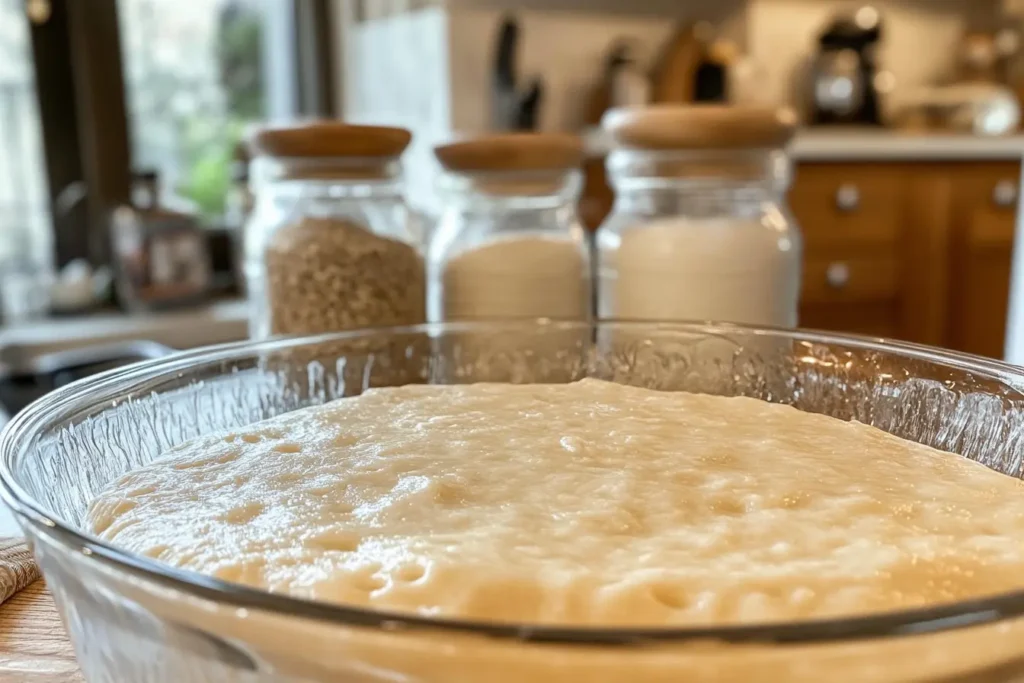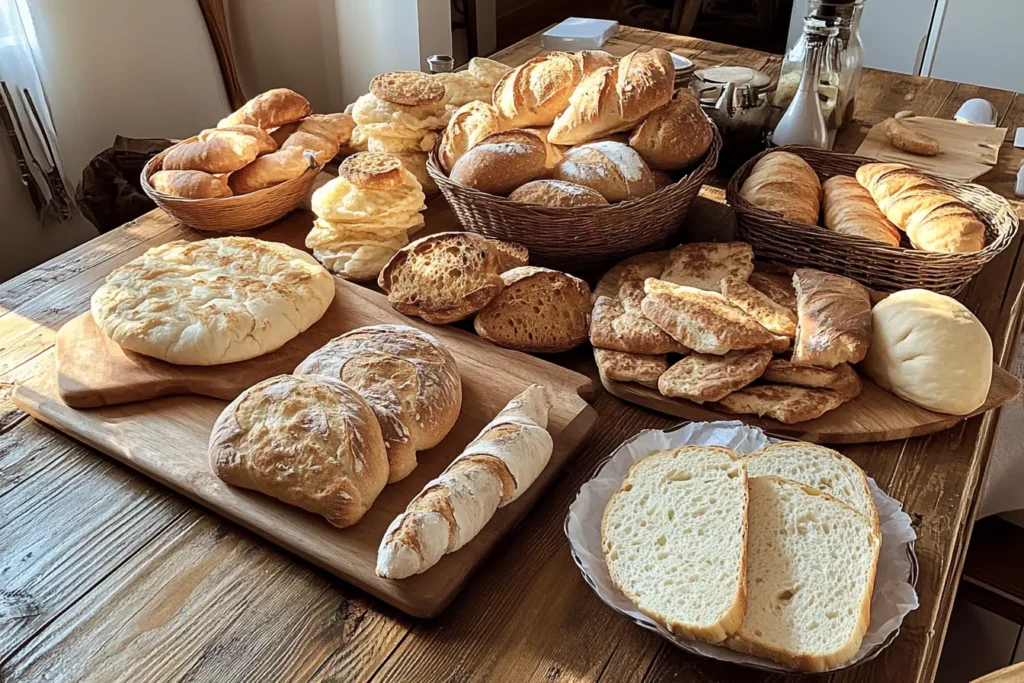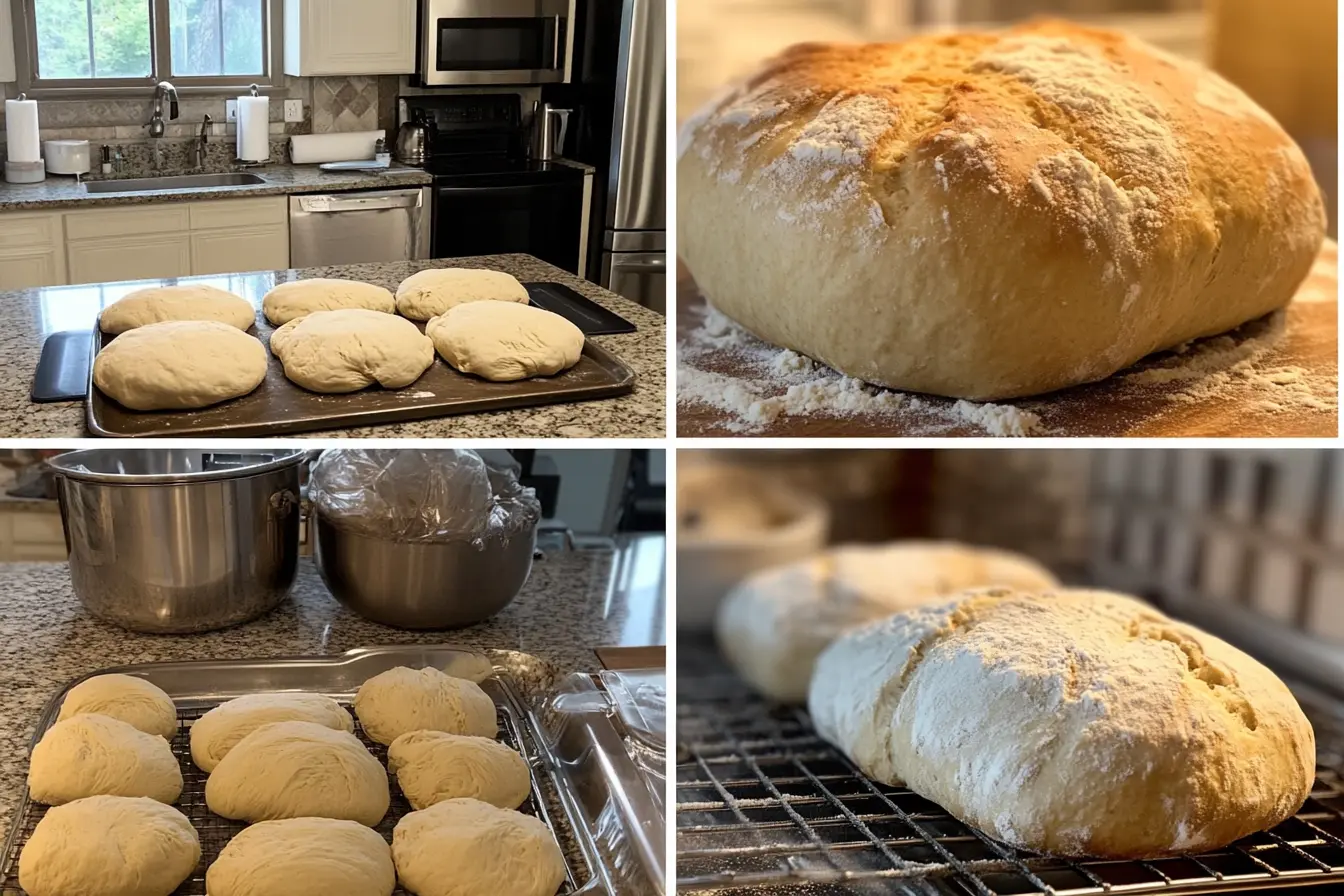Leavened bread has been a cornerstone of baking traditions for centuries, embodying history, culture, and science. But what truly sets this bread apart? From its origins to its modern-day applications, leavened bread is as versatile as it is fascinating. This article will explore the essence of leavened bread, the science behind its rise, and its enduring significance worldwide. Let’s dive in, starting with an introduction to the concept itself.
Understanding Leavened Bread
Definition
Leavened bread refers to bread that has been made to rise, typically through the introduction of leavening agents like yeast or baking soda. These agents produce gases during fermentation or chemical reactions, causing the dough to expand and become airy. This process distinguishes leavened bread from its flatter, denser unleavened counterparts.
It’s amazing how the seemingly simple act of leavening transforms the texture and flavor of bread. From the softness of a sandwich loaf to the fluffy layers of a croissant, the magic lies in this process.
Historical Background
The history of leavened bread is as ancient as civilization itself. The first evidence of leavening dates back to around 4,000 BCE in ancient Egypt, where natural fermentation processes were discovered. Early bakers noticed that when they left flour and water mixtures to sit, wild yeasts in the air caused the dough to rise.
As humans migrated and cultures interacted, leavened bread techniques spread across the globe. Each region adapted the process, introducing unique ingredients and methods, such as sourdough starters or steam leavening. Over millennia, leavened bread evolved from a serendipitous discovery to an essential dietary staple.
In the following segment, we’ll delve into the science of leavening, exploring the agents that make bread rise and how they work their magic.
Leavening Agents and Their Roles
What is Leavening in Bread Making?
Leavening in bread-making refers to the process that introduces air or gas into dough, creating the light, airy texture characteristic of leavened bread. This process can be achieved biologically, chemically, or mechanically. Each method not only adds volume but also enhances the flavor, structure, and appeal of the final product.
Whether it’s the bubbles from yeast fermentation or the reaction of baking soda with an acid, leavening transforms simple ingredients into the bread we love.
Biological Leavening Agents
Biological leavening agents like yeast and bacteria rely on natural fermentation processes. When yeast consumes sugars in the dough, it produces carbon dioxide and ethanol, making the dough rise.
Popular in bread varieties such as sourdough and brioche, biological leavening adds unique flavors and textures. Sourdough, for example, owes its tangy taste to the lactic acid bacteria in the starter culture.
Chemical Leavening Agents
Chemical agents like baking soda and baking powder offer a quick alternative to biological methods. These agents react with moisture and acids in the dough, creating carbon dioxide.
Ideal for quick bread recipes like banana bread or biscuits, chemical leaveners are efficient and predictable.
Mechanical Leavening Methods
Mechanical methods involve physically incorporating air into dough through vigorous mixing or whipping. Techniques like whisking egg whites or folding dough repeatedly can trap air pockets, giving the bread a light texture.
This method is often used in combination with other leavening techniques to enhance the result.
Soft Homemade Loaf
Ingredients
Dry Ingredients
- 3 ½ cups (450g) all-purpose flour
- 2 tsp salt
- 2 tbsp sugar
Wet Ingredients
- 1 cup (240ml) warm water (around 100°F/38°C)
- 2 ¼ tsp active dry yeast (or one packet)
- 2 tbsp olive oil or softened butter
Step-by-Step Instructions
- Activate the Yeast:
- In a small bowl, mix warm water and sugar. Sprinkle the yeast on top and let it sit for 5–10 minutes until it becomes frothy. This indicates the yeast is activated.
- Mix Dry Ingredients:
- In a large mixing bowl, combine the flour and salt. Stir thoroughly to distribute the salt evenly.
- Combine Wet and Dry Ingredients:
- Create a well in the center of the flour mixture. Add the yeast mixture and olive oil. Gradually mix until the dough starts coming together.
- Knead the Dough:
- Transfer the dough to a floured surface and knead for 8–10 minutes until smooth and elastic. Alternatively, use a stand mixer with a dough hook for 6–8 minutes on medium speed.
- First Rise:
- Place the dough in a lightly greased bowl. Cover with a damp towel or plastic wrap and let it rise in a warm area for 1–1.5 hours or until it doubles in size.
- Shape the Dough:
- Punch down the risen dough to release air. Shape it into a loaf and place it in a greased loaf pan.
- Second Rise:
- Cover the dough loosely and let it rise again for 30–45 minutes until it reaches just above the pan’s rim.
- Bake:
- Preheat your oven to 375°F (190°C). Bake the loaf for 25–30 minutes or until the top is golden brown and the bread sounds hollow when tapped.
- Cool and Serve:
- Allow the bread to cool on a wire rack for at least 15 minutes before slicing.

Nutritional Content (Per 100g)
| Nutrient | Amount |
|---|---|
| Calories | 266 kcal |
| Carbohydrates | 49 g |
| Protein | 8 g |
| Fat | 3 g |
| Fiber | 2 g |
| Sodium | 400 mg |
Types and Varieties of Leavened Bread
Common Types of Leavened Bread
Leavened bread, an international delight, comes in various forms that reflect the culture and creativity of their origins. It’s fascinating how each variety offers something unique, making bread an essential part of cuisines worldwide. Let’s explore some well-loved types of leavened bread.
Sourdough Bread
Sourdough bread is perhaps the most celebrated example of naturally leavened bread. With its signature tangy flavor and chewy texture, sourdough stands out as a healthier option for many. Interestingly, the fermentation process not only creates a distinct taste but also extends the bread’s shelf life. This makes sourdough both delicious and practical.
Brioche
Brioche is a classic French bread that is both rich and buttery. Unlike many other types of bread, brioche is slightly sweet, which makes it perfect for various uses, such as making sandwiches, French toast, or even enjoying it plain. Moreover, the combination of eggs, milk, and butter gives brioche its soft and tender crumb, making it a luxurious treat.
Baguette
The baguette, often associated with French culture, is admired for its crisp crust and soft, airy center. While its ingredients are simple—flour, water, salt, and yeast—the result is anything but basic. In fact, the baguette’s long and slender shape, paired with its unique texture, requires skillful handling. It’s no wonder this bread is a symbol of artisanal baking.
Pita Bread
Pita bread, a staple in Middle Eastern cuisine, is another type of leavened bread worth mentioning. What sets pita apart is its hollow center, which forms during the baking process. Because of its versatility, pita is often used as a wrap, a vessel for savory fillings, or even as a dipper for hummus or other spreads.
Other Varieties
Additionally, there are many other types of leavened bread, such as ciabatta, challah, naan, and focaccia. Each one has a distinctive texture, flavor, and method of preparation. For instance, focaccia’s dimpled surface and olive oil flavor are unmistakable, while challah’s braided shape makes it a centerpiece for special occasions.
In the succeeding section, we will delve into the profound ways leavened bread contributes to cultural traditions and religious practices across the globe. By doing so, we aim to uncover how this staple food not only nourishes but also strengthens connections to history, community, and shared identity.
Cultural and Religious Significance
Different Cultures
Leavened bread transcends culinary boundaries, finding a home in countless cultures around the globe. It serves as more than just sustenance; it symbolizes tradition, hospitality, and community. For example, in Europe, hearty loaves like sourdough and rye bread are often central to meals, reflecting centuries-old baking practices. Meanwhile, in the Middle East, leavened flatbreads like pita play a versatile role, used for wraps, dips, or stuffing.
In Asia, naan is a beloved accompaniment to rich curries, while in Latin America, pan de yema—a sweet, egg-rich bread—is a festive treat. This diversity showcases the adaptability of leavened bread to local ingredients and preferences.
Religious Perspectives on Leavened Bread
The role of leavened bread extends beyond daily life; it holds spiritual significance in various religious traditions. For example, in Christianity, bread symbolizes the body of Christ during the Eucharist. This ritual often involves leavened bread, representing life and resurrection.
Conversely, unleavened bread takes precedence in Jewish traditions, especially during Passover, to commemorate the haste in which Israelites fled Egypt. The absence of leaven signifies humility and a return to basics, contrasting with the celebration of life and abundance that leavened bread represents.
Leavened vs. Unleavened Bread in Religious Practices
The choice between leavened and unleavened breads in religious ceremonies often carries deep symbolic meaning. While leavened bread represents growth, prosperity, and divinity in many Christian rites, unleavened bread symbolizes purity and sacrifice in Jewish customs. These opposing symbols underline how bread, in all its forms, can be a profound spiritual metaphor.

Health Aspects and Nutritional Value
Nutritional Profile
Leavened bread provides a balanced combination of carbohydrates, proteins, and fats, making it a reliable source of energy. Additionally, its nutritional value can vary based on the type of flour and other ingredients used. For instance, whole-grain leavened bread contains higher levels of fiber, vitamins, and minerals compared to its refined counterparts.
Enriched leavened bread, often fortified with iron and B vitamins, contributes to essential daily nutrient requirements. Moreover, the fermentation process in naturally leavened bread like sourdough enhances its digestibility and boosts the bioavailability of nutrients.
Health Benefits and Considerations
Eating leavened bread in moderation can support a healthy diet. The complex carbohydrates in bread provide sustained energy, while its fiber content aids in digestion. Additionally, breads made with fermented starters may contain probiotics, which promote gut health.
However, some individuals may have dietary restrictions or sensitivities, such as gluten intolerance. In such cases, choosing gluten-free options or breads with alternative grains can help. It’s also worth noting that some commercial breads may contain added sugars and preservatives, so reading labels is essential for making healthier choices.
Leavened Bread in Modern Diets
In today’s culinary landscape, leavened bread continues to adapt to diverse dietary trends. Whole-grain and sprouted grain breads cater to health-conscious consumers, while artisanal options offer preservative-free alternatives for those seeking traditional flavors. Even plant-based diets can include leavened bread made without animal products, demonstrating its versatility and inclusiveness.
Frequently Asked Questions
What distinguishes leavened bread from unleavened bread?
Leavened bread is made with leavening agents like yeast or baking powder, which cause the dough to rise, resulting in a light and airy texture. In contrast, unleavened bread lacks these agents, leading to a denser, flatter form. Common examples of unleavened bread include matzo and tortillas, whereas leavened bread includes loaves, rolls, and buns.
What are the common leavening agents used in bread making?
The most common leavening agents are yeast, baking soda, and baking powder. Yeast works biologically through fermentation, while baking soda and baking powder react chemically to produce gases. Additionally, mechanical methods like whipping egg whites can also serve as a leavening technique.
Is sourdough considered a leavened bread?
Yes, sourdough is a type of leavened bread. It relies on natural fermentation, using a starter made from wild yeast and bacteria. This method not only leavens the bread but also imparts a unique tangy flavor and chewy texture.
Why is leavened bread not consumed during Passover?
During Passover, Jewish tradition prohibits leavened bread to honor the haste with which the Israelites fled Egypt, leaving no time for their bread to rise. Instead, unleavened bread, or matzo, is consumed as a symbol of humility and remembrance.
What are some examples of leavened bread?
Examples of leavened bread include sourdough, baguettes, brioche, pita, ciabatta, challah, naan, and focaccia. Each variety uniquely reflects its region’s techniques, flavors, and cultural significance, demonstrating the diversity of leavened bread worldwide. For instance, sourdough stands out with its tangy flavor and chewy texture, while baguettes charm with their crisp crust and airy interiors. Additionally, brioche offers a rich, buttery taste, and pita delights with its soft, hollow center. Furthermore, ciabatta impresses with its rustic, open crumb, challah captivates with its braided beauty, and naan shines as a perfect accompaniment to flavorful dishes. Lastly, focaccia brings a unique flair with its olive oil richness and dimpled surface. Together, these examples highlight the global appeal and versatility of leavened bread.
How does leavening affect the texture of bread?
Leavening introduces gases into the dough, creating air pockets that expand during baking. This results in a soft, fluffy, or spongy texture. Without leavening, the bread would be dense and compact, lacking the signature lightness associated with leavened varieties.

